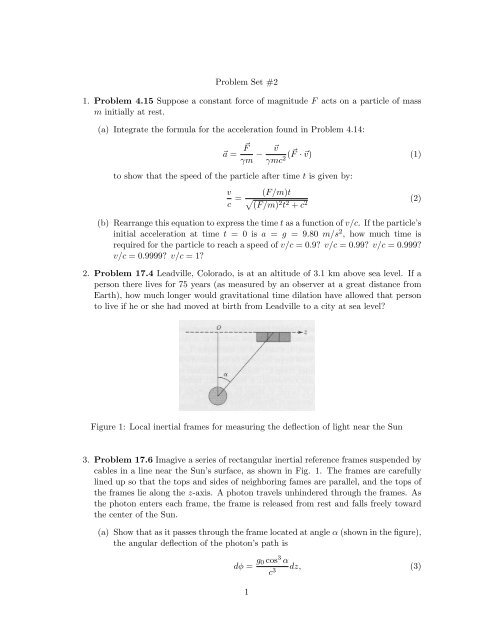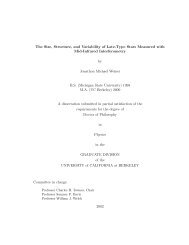Problem Set #2 1. Problem 4.15 Suppose a constant force of ...
Problem Set #2 1. Problem 4.15 Suppose a constant force of ...
Problem Set #2 1. Problem 4.15 Suppose a constant force of ...
Create successful ePaper yourself
Turn your PDF publications into a flip-book with our unique Google optimized e-Paper software.
<strong>Problem</strong> <strong>Set</strong> <strong>#2</strong><br />
<strong>1.</strong> <strong>Problem</strong> <strong>4.15</strong> <strong>Suppose</strong> a <strong>constant</strong> <strong>force</strong> <strong>of</strong> magnitude F acts on a particle <strong>of</strong> mass<br />
m initially at rest.<br />
(a) Integrate the formula for the acceleration found in <strong>Problem</strong> 4.14:<br />
⃗a =<br />
F ⃗<br />
γm − ⃗v<br />
γmc 2 ( F ⃗ · ⃗v) (1)<br />
to show that the speed <strong>of</strong> the particle after time t is given by:<br />
v<br />
c =<br />
(F/m)t<br />
√<br />
(F/m) 2 t 2 + c 2 (2)<br />
(b) Rearrange this equation to express the time t as a function <strong>of</strong> v/c. If the particle’s<br />
initial acceleration at time t = 0 is a = g = 9.80 m/s 2 , how much time is<br />
required for the particle to reach a speed <strong>of</strong> v/c = 0.9? v/c = 0.99? v/c = 0.999?<br />
v/c = 0.9999? v/c = 1?<br />
2. <strong>Problem</strong> 17.4 Leadville, Colorado, is at an altitude <strong>of</strong> 3.1 km above sea level. If a<br />
person there lives for 75 years (as measured by an observer at a great distance from<br />
Earth), how much longer would gravitational time dilation have allowed that person<br />
to live if he or she had moved at birth from Leadville to a city at sea level?<br />
Figure 1: Local inertial frames for measuring the deflection <strong>of</strong> light near the Sun<br />
3. <strong>Problem</strong> 17.6 Imagive a series <strong>of</strong> rectangular inertial reference frames suspended by<br />
cables in a line near the Sun’s surface, as shown in Fig. <strong>1.</strong> The frames are carefully<br />
lined up so that the tops and sides <strong>of</strong> neighboring fames are parallel, and the tops <strong>of</strong><br />
the frames lie along the z-axis. A photon travels unhindered through the frames. As<br />
the photon enters each frame, the frame is released from rest and falls freely toward<br />
the center <strong>of</strong> the Sun.<br />
(a) Show that as it passes through the frame located at angle α (shown in the figure),<br />
the angular deflection <strong>of</strong> the photon’s path is<br />
dφ = g 0 cos 3 α<br />
c 3 dz, (3)<br />
1
where dz is the width <strong>of</strong> the reference frame and g 0 is the Newtonian gravitational<br />
acceleration at the point <strong>of</strong> closest approach, O. The angular deflection is small,<br />
so assume that the photon is initially traveling in the z-direction as it enters the<br />
frame. (Hint: The width <strong>of</strong> the frame in the z-direction is dz, so the time for<br />
the photon to cross the frame can be taken to be dz/c)<br />
(b) Integrate the result you found in part (a) from α = −π/2 to +π/2 and so find the<br />
total angular deflection <strong>of</strong> the photon as it passes through the curved spacetime<br />
near the Sun.<br />
(c) Your answer (which is also the answer obtained by Einstein in 1911 before he<br />
arrived at his field equations) is only half the correct value <strong>of</strong> <strong>1.</strong>75”’. Can you<br />
qualitatively account for the missing factor <strong>of</strong> two?<br />
4. <strong>Problem</strong> 17.9 Consider a spherical blackbody <strong>of</strong> <strong>constant</strong> temperature and mass M<br />
whose surface lies at radial coordinate r = R. An observer located at the surface <strong>of</strong><br />
the sphere and a distant observer both measure the blackbody radiation given <strong>of</strong>f by<br />
the sphere.<br />
(a) If the observer at the surface <strong>of</strong> the sphere measures the luminosity <strong>of</strong> the blackbody<br />
to be L, use the gravitational time dilation formula:<br />
∆t 0<br />
= v (<br />
∞<br />
= 1 − 2GM ) 1/2<br />
∆t ∞ v 0 r 0 c 2 (4)<br />
to show that the observer at infinity measures<br />
(<br />
L ∞ = L 1 − 2GM )<br />
Rc 2 . (5)<br />
(b) Both observers use Wien’s law<br />
λmaxT = 0.002897755 m K, (6)<br />
to determine the radius <strong>of</strong> the spherical blackbody. Show that<br />
T ∞ = T<br />
(c) Both observers use the Stefan-Boltzmann law,<br />
√<br />
1 − 2GM<br />
Rc 2 . (7)<br />
L = 4πR 2 σT 4 e , (8)<br />
to determine the radius <strong>of</strong> the spherical blackbody. Show that<br />
R ∞ =<br />
R<br />
√<br />
1 − 2GM/Rc 2 . (9)<br />
Thus, using the Stefan-Boltzmann law without including the effects <strong>of</strong> general<br />
relativity will lead to an overestimate <strong>of</strong> the size <strong>of</strong> a compact blackbody.<br />
2
5. A flashbulb is mounted midway between two mirrors (the mirror at smaller x’ we’ll<br />
call ”‘left”’ and the one at larger x’ we’ll call ”‘right”’) which are separated by a<br />
proper distance L along the x’ axis. At time t’ = 0, two flashes are emitted, one<br />
traveling toward each mirror. The mirrors reflect the light back to the bulb and the<br />
bulb reabsorbs the photons.<br />
(a) Draw the Minkowski diagram used by the observers traveling with this apparatus.<br />
Be sure to show:<br />
i. The worldlines <strong>of</strong> the two mirrors, the flashbulbs and the photons (use dashed<br />
lines for the photons).<br />
ii. Put a label at the following events:<br />
• events A - emission <strong>of</strong> the flashes<br />
• event B - reflection <strong>of</strong> the front flash<br />
• event C - reflection <strong>of</strong> the rear flash<br />
• event D - reabsorption <strong>of</strong> the front flash<br />
• event E - reabsorption <strong>of</strong> the rear flash<br />
• event F - the right end (larger x) mirror at time t = 0<br />
iii. Which pairs <strong>of</strong> the following events are simultaneous?<br />
iv. Find the time (t’) for each <strong>of</strong> these events (in units <strong>of</strong> L and c)<br />
(b) Draw the Minkowski diagram for these same events using the station (S) coordinates<br />
(x and t). These observers see the apparatus traveling to the right (towards<br />
larger x) at speed u and they draw the x and t axes at right angles.<br />
i. Show the worldlines mentioned in ai.<br />
ii. Show the events A, B, C, D, E, and F.<br />
iii. Are the same pairs <strong>of</strong> events simultaneous?<br />
iv. What is the separation (∆x) <strong>of</strong> the mirrors? Label this separation on the<br />
diagram.<br />
(c) Find the spacetime interval (∆s) 2 between the events<br />
i. A and B<br />
ii. B and C<br />
iii. B and D<br />
3













![Problem #1 [Structure Formation I: Radiation Era]](https://img.yumpu.com/37147371/1/190x245/problem-1-structure-formation-i-radiation-era.jpg?quality=85)


